originally posted at https://canmom.tumblr.com/post/698091...
Once again, introduction before watching, review after.
Hi friends!
It’s Thursday - my last Thursday in America for the foreseeable future, in fact. On Monday I’ll be making a bizarre journey back to the UK via the ‘extremely direct’ route of Norway and Latvia, because it turns out that’s the cheapest way to get across the Atlantic. So that’s gonna be quite an adventure. I’m going to write some kind of post about things I’ve seen in America but probably when I get back for the sake of enjoying what time I’ve got left here…
Anyway, on to movies!
Tonight we’re going to be checking out a curious little sort-of trilogy of movies by different studies and directors from 2015, celebrating the works of the short-lived but influential science fiction author Satoshi Itō, aka Project Itoh.
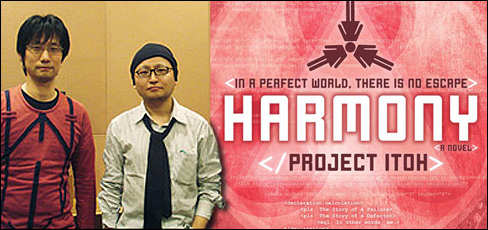
Here’s a picture of Itoh hanging out with his close friend Hideo Kojima at a book launch (via Metal Gear Trivia)
So who’s this Project Itoh guy? Born 1974 in Tokyo, there’s not a lot of biographical details about Itō’s early life, save that he went to Musashino Art University and worked as a web designer until the publication of his first novel, Genocidal Organ, in 2007.
What we do know is that he loved Metal Gear. Like, a lot. Itō got into Kojima’s games from the very start, and indeed most information about his life comes from Kojima’s account, alongside the blog where he published Snatcher and Metal Gear fanfic. The pair met at the 1998 Tokyo Game Show, at which Kojima was immediately struck by Itō’s devotion to his works, describing Itō as the one person who truly understand what he was writing about - an experience which ‘saved’ Kojima.
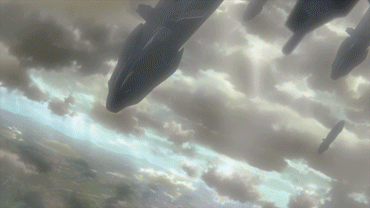
The two became close friends - and three years later, when Itō went into hospital with cancer in 2001, Kojima rushed to his bedside, and while there, showed him the first footage of MGS2: Sons of Liberty. Itō responded by promising he would not die until Kojima finished MGS2.
The experience of being hospitalised seems to have been very formative for Itō’s worldview. Youtuber The Canipa Project translates a blog post in which Itō talks about the experience of having his body sustained by scientific means only recently invented, making him a cyborg.
This time, Itō was able to keep his promise; when MGS2 came out, Itō wrote extensive analysis and exegesis of the game’s philosophical themes, getting a lot of attention within the fandom.
As the 2000s went on, it seems he judged it time to spread his wings and try releasing his own original stories under the pen name Project Itoh. The first, Genocidal Organ, was adapted from a fanfic he wrote about Snatcher into an original story. He submitted it to a novel writing competition in 2006, and while it didn’t win, he found a publisher in 2007; the novel became a hit, and so impressed Kojima that he asked Itō to take on the daunting task of writing a novelisation of Metal Gear Solid 4: Guns of the Patriots.

Itō apparently succeeded handily at the novelisation, and off these two successes, seemed set for a great writing career. His next novel, Harmony, dropped in 2008, dives straight into the themes of medical control; a dystopia in a post-nuclear war world where humans in the aftermath managed to cure cancer and most other diseases, only to institute a program of social control in an attempt to complete their utopia by eliminating mental illness as well. A story that’s clearly cutting pretty close to the bone from Itoh’s own experiences, since he was spending the 2000s dealing with recurrent cancer that took him back to hospital over and over.
And, indeed, the inevitable came in 2009, at which point Itō had just begun on his third novel Empire of Corpses. His cancer returned in force and he returned to hospital; once again Kojima went to his bedside and broke NDA to tell Itoh in detail about his next game, Metal Gear Solid: Peace Walker - that’s the odd PSP one featuring the Sandinistas. And once again, Itoh promised to live until Kojima finished the game, and write the novelisation of MGS3 and Peace Walker. But this time, it was a promise he could not keep; Itoh died at the age of 34.
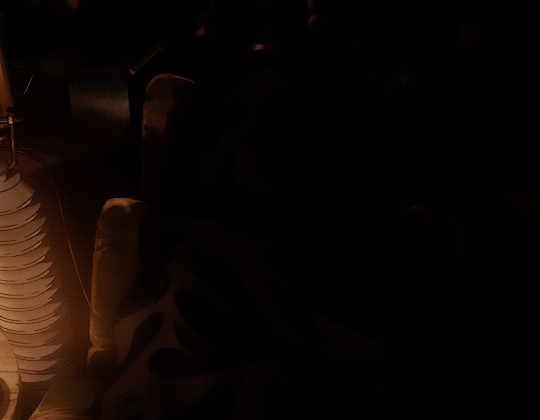
In the wake of his death, a devastated Kojima dedicated Peace Walker to him (and later revealed he had planned to name as a successor following MGS5), and his friend Toe Enjoe took on the task of finishing Empire of Corpses. Once again, I’ll turn to Canipa Effect’s translation of some of the words Itō wrote three months before his death:
Humans dwell in others as a story. People can continue to live within someone else as a narrative. Then, by being part of the variety of spoken words, they become part of the fiction that can shape humanity.
(Words that resonate too strongly with the death of my friend Fall earlier this year.)
So far, a tragic story - but in some sense one with a slightly hopeful touch, in that rather than dying of cancer in 2001, Itō was able to enjoy eight more years of life and write several novels. But what has it got to do with animation?
Enter Noitamina (the word animation backwards), the late-night anime programming block run at the time by Koji Yamamoto as a means to get experimental, creative animation - such as Masaaki Yuasa’s adaptation of The Tatami Galaxy or Kenji Nakemura’s BakeNeko and Mononoke - out to a wider audience. Yamamoto departed the block in 2015, but in its heyday it was home to a number of radically creative works; you can read more about it over here on sakugablog in a recent post on the context behind The Tatami Galaxy.
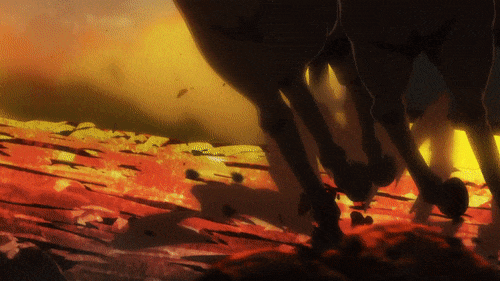
So, in 2015, Noitamina announced it would fund three movie-length adaptations of Itoh’s three novels, each by a different studio and director. For all three movies, the character designer would be illustrator redjuice of the ‘band’ Supercell, a somewhat odd musical project consisting of just one musician and ten illustrators and designers who produce materials around the music.
Genocidal Organ would go to the hands of Shūkō Murase, at Studio Manglobe, a unique studio renowned for original works like Shinichirō Watanabe’s Samurai Champloo, Ergo Proxy, and Michiko & Hatchin (the latter of which I covered back on Animation Night 36). Murase seems like a natural choice for a highly philosophical cyberpunk story, given Ergo Proxy… but a spanner was thrown in the works when Manglobe went bankrupt; Genocidal Organ would eventually be saved by the resurrected Manglobe in the form of Geno Studio, but for this reason, it missed the planned simultaneous release of the three movies.
The story concerns a world in which a series of social breakdowns and genocides take place in a short period of time, all seemingly associated with an American named John Paul - who, when tracked down, claims to have discovered a ‘genocidal organ’ which can be activated to incite humans to acts of genocide. Without giving away too many spoilers, it’s basically about the current American-dominated geopolitical order.
On the animation side, the stars of the show would be Bahi JD, the Austrian from the earliest wave of sakuga fandom who became one of the first international ‘webgen’ animators to find a career in Japan… and Shūkō Murase himself, who animated several cuts as well as directing the film. As such, even a quick look at sakugabooru shows a lot of subtle, well-observed movement; I’m looking forward to seeing it fit together.

Harmony - the post-cancer dystopian one - went to Michael Arias at studio 4°C, of Tekkonkinkreet fame (see Animation Night 52 for Tekkonkinkreet, and Animation Night 74 for a more detailed history of 4°C), alongside veteran animator and director Takashi Nakamura who you may remember from the Chicken Man and Red Neck sequence of Robot Carnival. It comes at a point where 4°C had found a lot of comfort with their use of CG, two years before Mutafukaz (Animation Night 105), and even if the incredible background artists of Tekkonkinkreet may not be on this one, I imagine it will look pretty lavish as 4C stuff always does.
Then comes The Empire of Corpses. This one goes to Wit Studio (Animation Night 101), directed by Ryōtarō Makihara - also no stranger to scifi, with his main previous work being Hal, the story about a robot designed to play the role of a deceased partner. Unlike Itō’s other works, which are near-future science fiction, this one is more of a steampunk piece, taking place in an alternate 19th century in which mass produced Frankenstein’s monsters have become the industrial base of society; its characters bounce around the globe unearthing a conspiracy. It sounds kind of wild, honestly, with not just Frankenstein and Babbage but even frigging Sherlock Homes running around; Japanese spins on British characters like this are always kind of fascinating. (Also… there is some tragic irony about a story revolving around reanimated corpses being completed by Itō’s friend after his death.)
So, that’s the plan for tonight: we’re going to be watching all three Project Itoh movies, in the order that Itoh wrote them! I think there’s gonna be some great stuff in here, and I hope I’ve given you reasons to be excited too~
so, if you’d like to check these out, please make your way down to twitch.tv/canmom - we’ll be starting the program in about 20-30 minutes once people are in there!
Now we’ve watched the films, here’s my sort-of-customary followup post where I actually talk about their content (instead of brief summaries and production anecdotes…)
We watched the films in the order that Itoh wrote the novels, and this I think proved a good choice, because both Genocidal Organ and Harmony are heavy, slow, cerebral movies in the tradition of Oshii and Okiura… and Empire of Corpses is more of a Wit Studio action piece, somewhere between Steamboy and a Tetsurō Araki project. That said, absorbing all three at once is quite a mouthful, and if you feel inclined to watch them I’d probably space them out over a few days!
And I absolutely recommend watching all three movies, the first two especially. So let me talk a little more about them…
Genocidal Organ
Genocidal Organ is most akin to a spy thriller with what I can only describe as a surprisingly Third-Worldist bent. It’s the one that’s most Metal Gear in flavour, with tense spy antics leading into futuristic military violence that is brutally well-choreographed, somewhat calling to mind Dahufa. It serves as a pretty good introduction to Itoh’s thematic concerns - anything but subtle, but does not suffer for it.
I watched the film in Japanese with subtitles, but having listened to the dub a bit while composing this post, I would actually say it’s very strong, and might be worth watching as a more accurate fit to the languages diegetically spoken by the characters.
The sci-fi premise (outside of fun little setting details like widespread use of ‘artificial flesh’ manufactured from whales by child slaves) is that humans have a kind of behaviour module that promotes hyper-violent, genocidal behaviour as an artefact of our evolutionary history, which can be activated by the right string of words - sort of like a curse. This comes to us gradually by way of the main spy boy and his love interest nattering about Chomskyian linguistics (no name drop but you can see his influence) and Kafka, who is alluded to throughout the story.
Gradually we learn that the villain’s motivation is to promote violence across the world to prevent everyone else turning their weapons on America. All of this is framed, however, through a small cluster of interpersonal relations; Itoh characters will talk often grandly about the fate of the humanity but tend to prioritise, in the end, the few people closest to them in their actions. And so it has the fascinating resolution where the main character concludes the only way he can be true to his deceased love interest and undo the work of the villain, whose deeds would otherwise be covered up or forgotten, is to activate the ‘genocidal organ’ in America as well.
This premise is… kind of wack in one sense, in that the idea of a special genocide man who causes the genocides through magic words has little to do with why actual genocides take place. It’s a fantasy akin to ‘neurolinguistic programming’; fortunately there is no reason to believe that you can basically use a magic spell to seize control of someone’s brain. And yet, as a metaphor, it does have a certain insight - in that it very explicitly relates all this violence back to the imperial core, that it’s being done for the sake of giving one set of people a comfortable life at the cost of another. Indeed, it’s pretty heavy handed with stating this, when we finally get to the point where everyone states their motivations plainly…
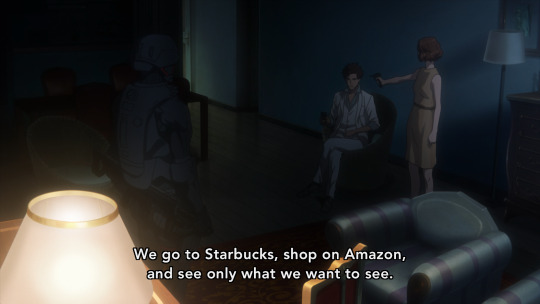
There’s a strong current here as well of the aftermath of the war on terror - with its discussion of freedom, and the growth of the security state hoping to prevent terrorism, you can definitely see that it was written in the 2000s.
The future genocides of this film are generally not shown in detail; instead the references to genocide go back to real ones of the 20th century, starting with the decision to open with a nuclear bomb going over a memorial in Sarajevo. (I can only speculate that, much like Yoko Taro, watching news of the Yugoslav wars in the 90s made a heavy impression on Itoh.) The question that it’s struggling with is in part ‘why are humans capable of this’; the villain’s answer is that there is a vestigial psychological ‘module’ - the titular ‘genocidal organ’ - that makes humans indifferent to violence, one that is adaptive as a way to handle resource scarcity. I’m not sure I buy this answer, but I don’t exactly have an answer myself.
The fact that this guy is an immense metal gear fan is immediately apparent in the dialogue, endearingly full of dense autistic infodumps. (There’s one very funny moment where a character says he was talking about ‘freedom as currency’ to the main female character, and she responds ‘Again?’) Also like Metal Gear, there’s a fascination with sci-fi military hardware; this is a world where the US military fantasy of a high tech invincible special force which can rapidly deploy to anywhere in the world has seemingly succeeded, rather than being a sort of dick-waving money pit. An action sequence late in the film sees the protagonist deploy from a high altitude plane in a kind of heavily armed drop pod, which then disintegrates once he has departed; the plane stays up there to hit enemy snipers with high altitude air strikes, and the whole operation goes like clockwork.
Still, it’s not just gratuitous military fetishism - the dystopian concepts are heavily present, with these US soldiers drugged and conditioned to feel nothing at all about slaughtering child soldiers by the dozen. The violence is shown as appropriately abrupt and nasty, not heroic. In this regard, it reminded me of the Farewell to Arms segment of the Short Peace anthology, which also tried to imagine a more realistic take on a high tech future war.
One very cool touch is that there are a lot of POV shots using the soldiers’ augmented-reality vision - a device it shares with Harmony, but here it has the effect of making action scenes (of slaughtering almost defenseless child soldiers) feel rather like an FPS, something I can only assume is a conscious choice. These make a very clever use of CG backgrounds with painted textures that fit in very naturally with the painted backgrounds in static shots, and very strong compositing to fit the traditional animation into the scenes.
All in all, if you can swallow some questionable scientific premises, it’s a very compelling film in the vein of Metal Gear, Patlabor and Psycho-Pass - though as far as Psycho-Pass is concerned, the next film seems even more relevant…
Harmony
I went into Harmony with a vague idea of the setting premise but not much about the specific plot. The answer is that it’s about a lesbian death cult, with suicide articulated as a means to insist on bodily autonomy when all other avenues are lost. So, phew!
Also it name drops Foucault at one point. It’s that kind of story.
With such a premise - a scifi dystopia where there is a closed society exercising overbearing social control in the name of health, not to mention Foucault namedropping - it’s hard not to think of Psycho-Pass. I don’t know if the novel was an influence on Psycho-Pass, or if they’re just pulling from a similar pool of influences.
Compared to the other two films, which are more action-oriented, this is a much slower, more dreamy film - the one that comes closest to an Oshii film in terms of pacing, complete with long pans over cityscapes as characters travel from one place to another. (Not that it’s completely without action, with a couple of strong chase sequences.) The sterile medical world is mostly realised in CG, full of abstract shapes that look kind of like a bunch of sex toys - though outside the domain of the ‘Admedistration’ we do see 4C’s flair for beautiful painted backgrounds.

The mystery this time is a sudden mass suicide cutting across the society, whose perpetrators claim that they can induce anyone to suicide at will. The protagonist, a ‘Helix Investigator’ acting as the foreign policy/cop wing of the Admedistration, concludes - correctly - that this event is somehow related to the suicide pact she formed with a childhood girlfriend. Much like Genocidal Organ, the film gradually constructs a picture of its antagonist Miach and her ideology as the protag Tuan investigates and attempts to locate her.
From there it goes some wild places: it’s ultimately about P-zombies (though it never uses the word), and more precisely, the idea that someone could be induced to become one. Here, Itoh even more explicitly invokes the idea of the mind as being made of multiple competing desires, relating the notion of ‘will’ to ‘consciousness’ in contrast to ‘purely axiomatic’ behaviour of someone without consciousness. We learn that Miach came from an ethnic group in Chechnya that are genetically all P-zombies, but awoke to consciousness after sexual torture, only to find the Japanese society that ‘kills with kindness’ and expects everyone to function neatly in the social body just as unacceptable.
But after her suicide fails and she is abducted and experimented on by a conspiratorial organisation, who temporary suppress her consciousness and make her live for a time in the blissful state of a P-zombie, she comes around to desiring this global suppression of consciousness, an event which ultimately goes ahead - but not before before she can herself become a P-zombie. “Stay as the Miach I loved!”
The CG is by and large exceptionally well composited (naturally, it’s 4C), particularly when it comes to sometimes rendering the characters in CG - a still frame of which could be easily taken for a drawing. There are some fascinating visual ideas, though, like the ‘Medical City’ of a future Baghdad that is one enormous mosque-like tower…
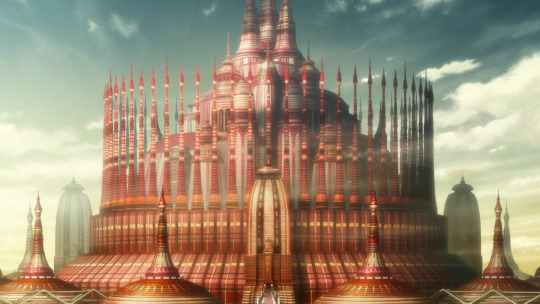
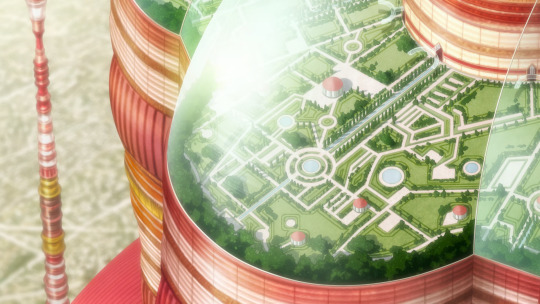
The philosophical ideas of this film seem to be pretty central to Itoh’s worries. We can think of the P-zombie plan as akin to something like the ‘total causal closure’ desired by the Masquerade of Baru Cormorant - removal of everything that is non-deterministic about human behaviour. Here, this loss of consciousness - the Harmony system, created by an attempt to directly control human will - is a possibility that is discovered, but suppressed, kept around only as a last resort plan by the Next Gen Human Behaviour Working Group conspiracy. So Miach and her allies attempt to induce a social breakdown bad enough to motivate the activation of this ‘Harmony’ system.
For Itoh, I can only imagine the question of social control through medicine must have felt particularly acute. He remarked about how medical technology sustained his life and made him a cyborg, but spending so many years going in and out of hospitals at the edge of death must have given him a pretty hefty does of that strange psychic space that a hospital’s architecture conjures, and thus we end up with this picture of a society as a universal hospital.
As with Genocidal Organ, while the story may be about grand questions of the fate of humanity, the characters are mostly concerned with smaller scale personal questions. Which the protagonist at one point states directly…
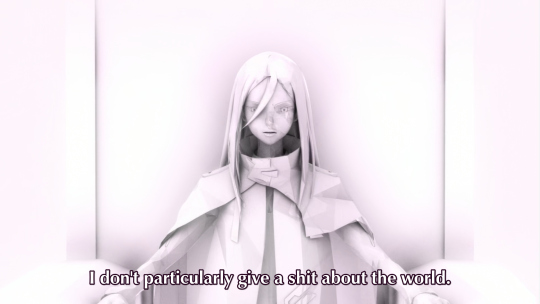
It makes me think of the concept of sekaikei, although I don’t think any of these films really fit that template exactly - but it’s interesting I think to look at what motivates an Itoh character when a lot of these films orbit the question of ‘will’, i.e., motivation.
Anyway, here’s the point that the film straight up pulls a Foucault quote…
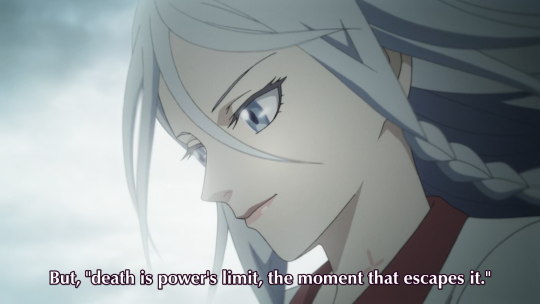
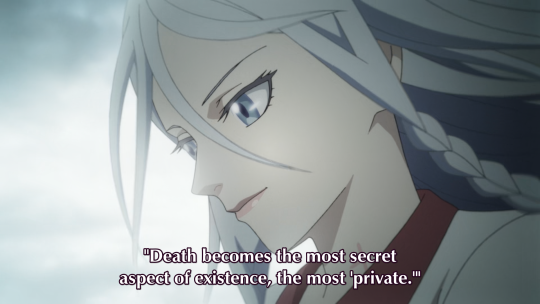
But it also seems as if the arc of Miach changing her tune to wish to see humans free from consciousness and desire could be read in a Buddhist light? Buddhist imagery is more present in the third film, but, you know…
This is also the film of the three whose homoeroticism is most explicit (as in, explicit at all). Miach is a weird little death cult leader but also her relationship with Tuan is clearly romantic and sexual as well; it’s not made a huge thing of but it adds a lot to their dynamic. The other films, by contrast, while they definitely could have homoeroticism read into them (Empire of Corpses especially) don’t make it nearly so evert.
Anyway, I enjoyed this film a lot. It’s hard to figure out how to compare it with Tekkonkinkreet; visually they are very different, but both of them are concerned with overbearing power and the paradoxes of rebellion, and both of them have a sense of slow build and a lot of striking visual setpieces. I hope Michael Arias ends up directing another anime film at some point; it seems his efforts have lately been turned to live action films and manga translation, but he’s directed some ace films.
The Empire of Corpses
This one’s… odd, honestly! The Itoh thematic concerns are definitely present, but it feels much more like something influenced by other Wit Studio works such as Attack on Titan or Kabaneri of the Iron Fortress, with the same blindingly high-contrast compositing, high action quotient and closeup-heavy direction.
The biggest thing I missed while reading up on this film beforehand is that the protagonist is actually John Watson - as in, Sherlock Holmes’s sidekick. Holmes does not feature in this film, but it is packed with allusions to Victorian literature and famous historical figures, from Frankenstein’s monster to the Nautilus, now in the hands of Thomas Edison.
This is a world whose economy is based on reanimated zombies, programmed via Analytical Engines, a compelling concept which leads to some strong images of corpses smashing each other to bits for the sake of war. Watson has, essentially, a zombie boyfriend (who acts as a kind of walking stenographer-computer) - someone who, with John, wants to figure out how to create a walking corpse with a soul like Frankenstein’s original monster. To this end, John is hopping across the world in search of Victor’s Notes, a set of punched cards which contain the secret to a zombie with a soul. But the Notes open the door to another possibility: a way to provoke all the zombies into violence and create a world of programmed corpses, as the British spymaster wants, or else to… gather the souls of people from across the world in order to perform a resurrection, as the original Frankenstein’s monster wants? Honestly the film gets rather hard to follow once the big light show starts up.
The film is certainly lavishly animated - I can only speculate what the drawing count was, because it’s full of complex character animation and action scenes. While Wit’s compositing style is very hit and miss for me, I can appreciate the enormous effort that has gone into realising it. The awkward shambling motions of the zombies, particularly Watson’s zombie boyfriend, are an especially strong element.
The section that takes place in Japan has some of the most fun designs in the film, from giant corpse-samurai to the main Japanese character who has these splendid eyebrows…
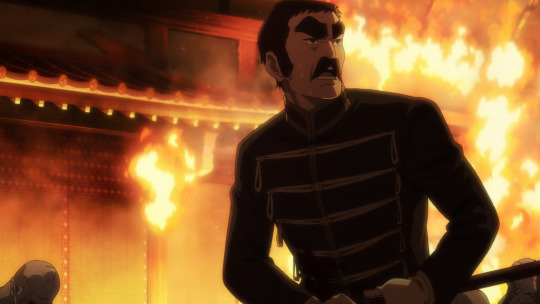
…even if its visit to this setting doesn’t really address much about the fact that Japan was in the process of becoming an expansionist empire at this point, something that seems like an oversight in a film about the evils of empire yknow.
Anyway, overall, this film reminds me rather a lot of Steamboy, not just because of the nineteenth-century setting; it has lavish animation and clearly some of the same thematic concerns behind it, but doesn’t quite seem to come together to form an unsettling emotional arc as the others do. Ultimately, Frakenstein’s monster and M are both defeated, Watson succeeds at using the Notes to restore a soul to his corpse companion through some kind of act of sacrifice, the gynoid woman becomes Irene Adler, you see you see. It seems far too easy and straightforward an ending to satisfy.
Still, it’s a fun ride, and it definitely has some cool images. I think it’s worth a look in, if only to enjoy some rich animation and witness anime Ulysses S Grant. Even a Kameda action scene! Plus the relationship between Watson and his zombie is fun.
Overall…
Honestly I feel like even with all this I’ve barely scratched the surface of all that’s going on in these films. I can see what the fuss is about with Itoh; he feels just as much of an eagerly obsessive autistic weirdo writing about what’s in his RSS feed as Kojima is, and it’s really endearing. I’m grateful of his eight years of cyborg existence, and glad to assimilate part of his ‘spoken narrative’ to shape my small part of humanity…
As far as adaptation goes, I can’t say how much these films abridge or change Itoh’s stories to adapt them to screen. None of them really feel incomplete, but even a two hour movie will have a hard time packing in as much material as a novel. I’m a very long way from reading Japanese literature in Japanese, but this is all the more reason to want to get there and see what Itoh had to say in his own voice.
All in all, these films exceeded my hopes, and I’m very glad to have finally seen them…
Two weeks now until the third Animation Night halloween, when we’ll watch Mad God. In between now and then is Animation Night 128, so I’d better think of something computer-y, huh. We’ll see. See you back in England, under the shadow of the giant corpse reprogramming tower, everyone!
Comments